I've seen a lot of things happen with intranet implementations. The biggest problems have always occurred when there was no real plan in place to follow step by step. Many teams have often sprinted from start to finish, without thought to what comes next. Therefore, anyone involved in building a modern intranet should definitely take the following to heart:
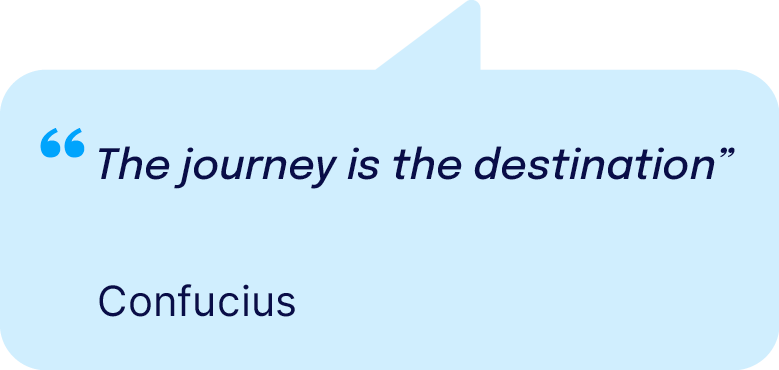
This is definitely also smart advice for the introduction of a modern intranet. The technical provision of a new intranet platform is often done quickly, especially in these times of standard solutions and cloud services. But that alone is not enough when building a modern intranet. You need a plan.
The following article will provide you with seven tips to help you successfully launch an intranet:
- Know your main target groups and most important stakeholders
- Divide your project into 3 phases
- Create a good intranet strategy
- Get the setup right. Build a foundation that generates acceptance and involvement.
- Plan for continuous improvement after the launch
- Create a checklist and use it
- Plan and prepare - but stay agile

Tip 1: Know your main target groups and key stakeholders
If you plan on building a modern intranet, the very first thing you should think about is who it's for and which stakeholders you need to involve on this journey. We have summarized the most important target groups and stakeholders in our view below.
Target group (employees)
The most important and decisive target group is your employees. The success of the new intranet stands and falls with them. It is absolutely essential that those responsible for content know their target groups (often referred to as segments) and understand their needs. This sounds pretty simple at first, but it should be thought through carefully.
Test your knowledge about the target groups and answer the following questions for your company:
- What is the distribution between permanent and non-permanent employees (desk workers vs. non-desk workers)?
- Which digital communication channels exist and which do you really need?
- What are the target groups in terms of the type of work (fields of activity) in the company?
- How is access to information and communication, especially at remote locations?
My most important finding of the last ten years is that there is no one-size-fits all digital workplace for every employee. The type of job (task in the company) plays a major role and is therefore one of the most common distinctions for employee groups:
- Remote employees who do not have a fixed workplace (synonyms for such roles are non-desk workers, blue-collar workers, or non-wired workers); for example, employees in factories.
- Process employees who perform standardized activities at a fixed workplace; for example, call-center employees
- Information workers who focus on digital collaboration within departments or in project groups.
However, you can also define further target groups according to business units, locations, or even management activity.
Target group (blue-collar workers)
In the last five years, the target group of blue-collar workers has increasingly become the focus of corporate communications. The urgent need for crisis communication due to the Covid-19 pandemic has accelerated this trend. We have published a video on the topic of understanding your target groups and personas as part of our Internal Communication Masterclass.
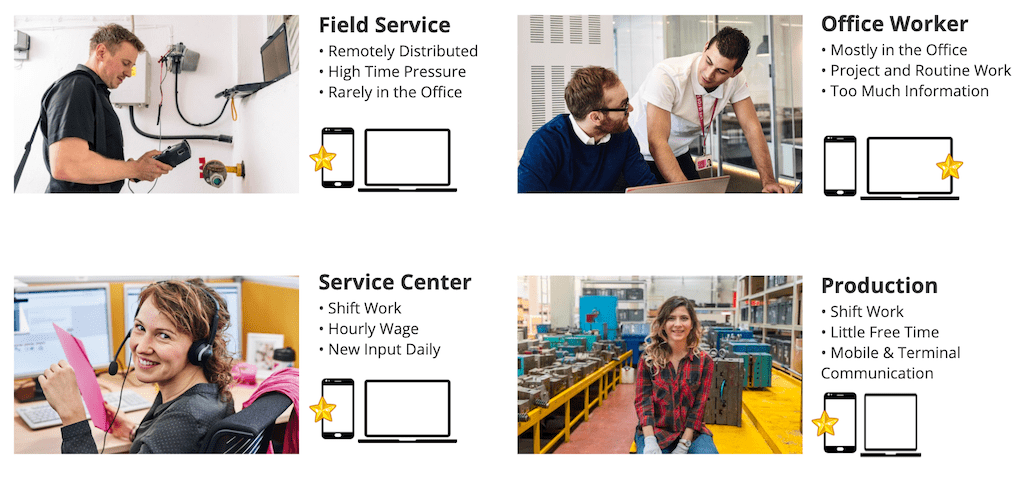
Target group (project sponsors and management)
In order to be able to start building a modern intranet, you must first meet with management about your plans and convince them of the necessity. Finally, management approves the budget and ensures that internal capacities are available for the project, both temporarily and permanently.
The most important question for top management to answer is, "Why should we do this? A chain of argumentation with regard to "What could happen if we don't act now?" often helps as well. For project sponsors and middle management, answers to the "how?" question still play a role.
From the project perspective, all management levels have one thing in common: they are important advocates and therefore also act as role models for the new intranet project and for a new communication culture. Only if they themselves see the added value of building a modern intranet can their conviction pass to rank-and-file employees, some of whom will also use the system voluntarily on their private devices and actively participate in dialogue formats.
Target group (project team)
As soon as a project is in place, a core team is usually assigned to it. It's important that these members are then released from their regular operational activities. Depending on the size of the project, this can be done temporarily, full-time, or on a pro-rata basis.
We have also had good experiences with having an extended project team in addition to the core team. In my projects, this team often acts as a "sounding board." Essentially, their job is to give feedback to the core team on technical issues. But it is also very valuable in the other direction, namely when it comes to communicating the project goals and progress to the organization. The sounding board doesn't usually have decision-making authority, but it can assist in making decisions.
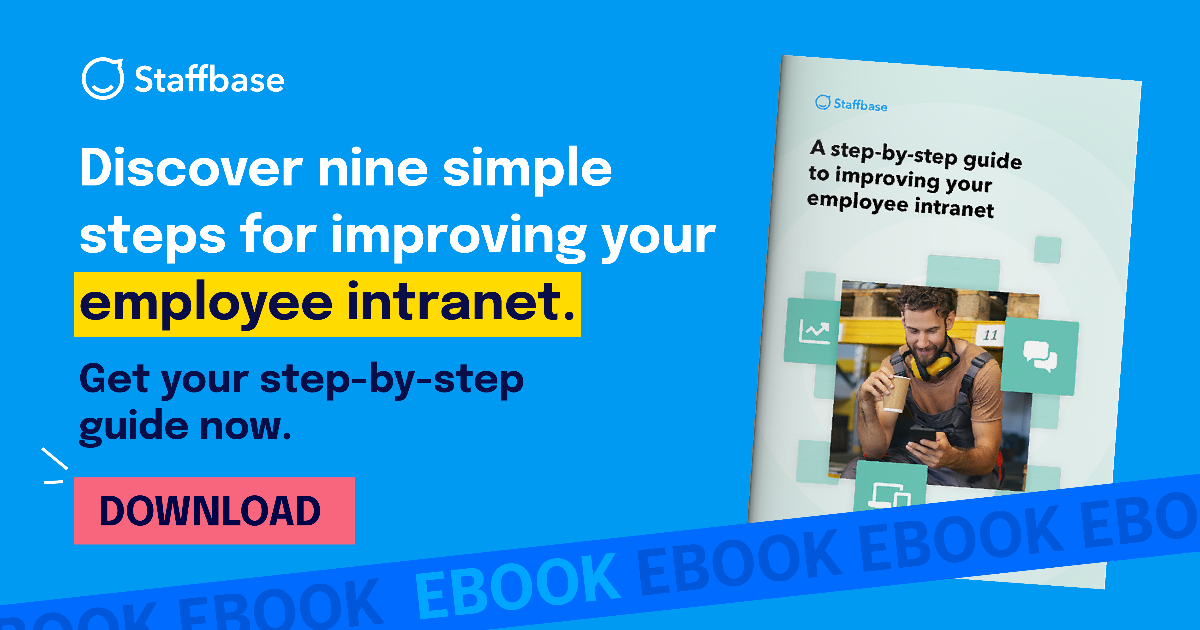
Tip 2: Divide your project into 3 phases
Above all, the path toward a new type of intranet is crucial for acceptance and use. In our blog article How to Create the Best Modern Intranet for 2021 we describe the evolutionary steps of intranets, especially in regard to the topics of communication and collaboration.
A lot has changed since the intranet projects of a decade ago. The path to building a modern intranet is different today than it once was. But regardless of the framework conditions and the initial situation in a company, every intranet project goes through three phases that build on each other:
- Strategy
- Setup
- Rollout & Continuous Improvement
The growing trend to use standardized SaaS solutions makes the entire software evaluation process easier than ten years ago. Extensive specialist concepts are no longer necessary. Of course, this also has an impact on the focus and time horizons of the individual work packages and milestones within the phases.
The specific design of the phases also depends on parameters such as the communications strategy, the size and distribution of the company, and the existing IT framework conditions.

In the following tips, we explain in greater detail what the phases include in terms of content.
Tip 3: Create a good intranet strategy
The first phase, Strategy, is primarily concerned with defining the guardrails for the project. This is why classic project management tasks play a particularly important role here, such as setting up a vision, defining goals and non-goals, planning the necessary internal and external resources, planning and approving a budget, and taking stock of the current intranet solution.
Technology selection
An important component of this phase is the selection of technology. The main goals for internal communication must be to reach all employees with the new intranet and also to maintain sovereignty over the management of the platform - this includes, for example, the central administration of the menu structure and content creation.
In the past, technology decisions were often made with only office workers in mind (even in companies with a workforce of diverse job roles). In addition, attempts were made to use social intranets to map most use cases - from top-down communication to communities to collaboration - with just one platform.
As a result, many social intranets were so complex that employees had to proactively configure their settings in order to see relevant content. Particularly for the target group of remote employees, relevance of content is even more important than it is for knowledge workers, since their use of the intranet or the employee app is completely voluntarily and often done on their private devices.
Basic idea and goals of the intranet
Therefore, the orientation and definition of intranet goals is often a philosophical decision. Is it more about a pure technology replacement and "business as usual" or is the intranet being completely rethought? Is the intranet seen as the digital workplace, encompassing both communication and collaboration? Or is it about a central information and communication platform for all employees, where dialogue and exchange are presented in the foreground? In this case, collaboration use cases are separated out and take place in separate platforms such as Microsoft Teams. In this case, collaboration tools are often irrelevant to certain employees, or the type of collaboration can differ completely depending on their specific field of activity.

Studies confirm: Teamwork is increasingly not the intranet's responsibility
Our intranet study of 2021 reveals that intranet managers are unsure about the basic goals of their intranets. That's why it's so important to address this question in the strategy phase.
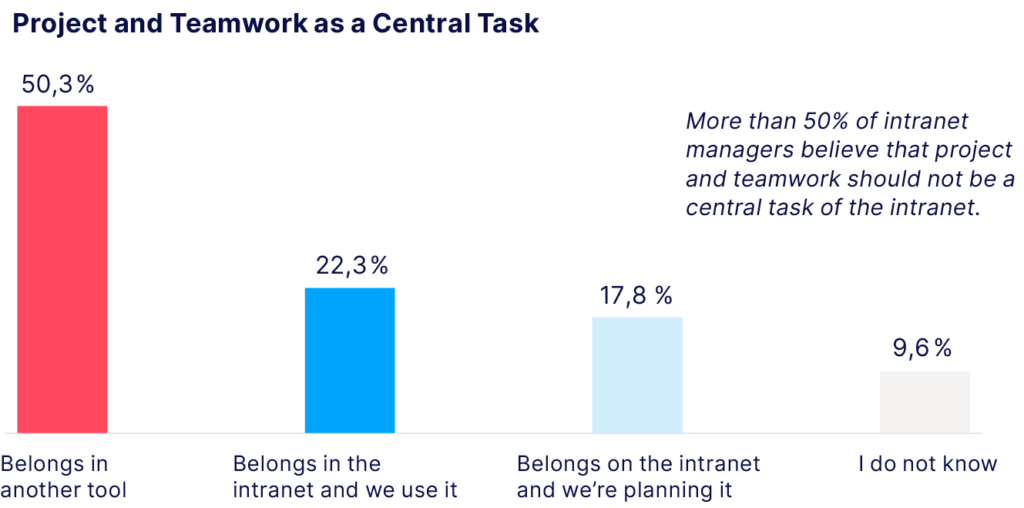
In the following figure, we see an example of an IT strategy with regard to the combination between an intranet and a collaboration world based on Microsoft 365. This is exactly the kind of strategy that has led to success at MAN Truck & Bus SE.
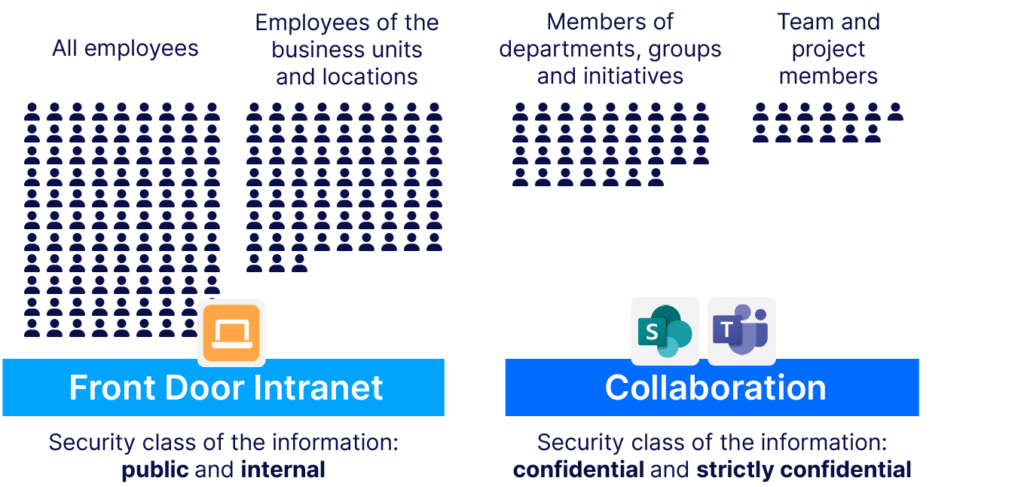
What is important to consider when deciding on technology: From an IT perspective, it can also make sense when building a modern intranet for it to happen independently from the rollout of Microsoft 365, for example. On the one hand, this has the advantage that the core requirements of internal communication can be implemented more quickly and, on the other hand, that short-term adjustments are also possible without major IT effort. This also means that there are no critical dependencies on Microsoft rollouts, for example. In addition, IT can concentrate more on customer-specific IT applications.
Internal communication with new role
The role of internal communications also needs rethinking in some cases. Is it primarily the administration and management of central communication that is important, or is it also the empowerment of decentralized multipliers or champions; for example, at remote sites or in specific departments? This is also a lot about trust and expectation management in the project team and the entire organization. Open communication and exchange can have a positive impact on the corporate culture. However, this takes time, and a company must decide for itself which steps it will take along the way.
User management
Another important IT consideration is user management. Why? Knowledge workers were primarily the focus of earlier social intranets, for whom established processes already exist. However, these often do not apply to the target group of non-desk workers. These employees usually don't have an internal company account or a company email address. Therefore, you need a strategy that ensures user onboarding and user management for all employees. In practice, hybrid approaches often work; for example, user management of office employees happens in a central user management system (e.g., Microsoft Azure AD), while non-desk workers have a user name and password. It is also essential that user data is available for segmentation to enable target-group-specific communication and information sharing.
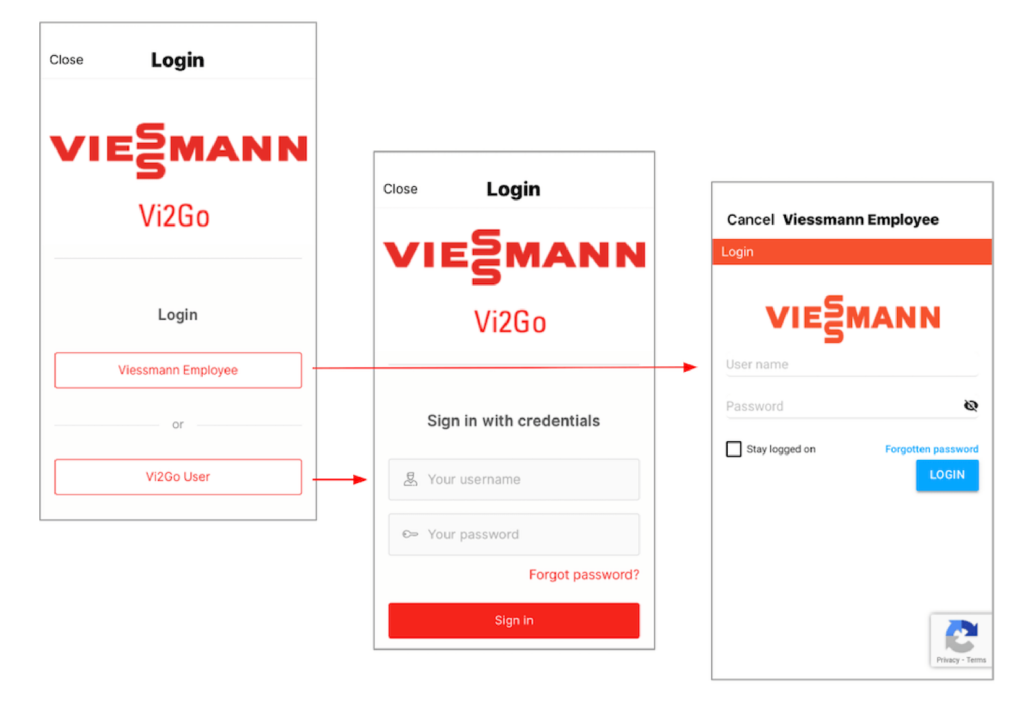
But what else is important for IT in the decision-making process? These are primarily issues such as the scalability of the platform, flexible expansion through available interfaces (APIs), and the possible consolidation of systems that are no longer necessary, such as newsletters, or the intensive maintenance of customized platforms.
Tip 4: The setup must be right: Build a foundation for acceptance and engagement
Finally, the setup phase is about detailed planning and implementation. Existing intranets often provided little to no relevant content for their target groups. This cannot be the case when building a modern intranet, which is why the planning phase is so crucial.
Building an editorial network
Internal communications must ensure that there are advocates and editors at all levels in the company. Setting up a network of multipliers is therefore crucial for the success of the new intranet. Colleagues from the departments and locations know best what concerns employees and what information they need and in what form. You also need to empower decentralized influencers to shape information and communication in a way that resonates with employees, from training on platforms to understanding key personas to brainstorming new use cases and trying out different content formats such as video, podcasts, and storytelling.
Keep your eyes open for unofficial intranet champions and win them over to your cause. The unofficial champions are the employees who create relevant content for a target audience (such as a specific location or topic). This content usually has good reach and a high level of interaction (e.g., via comments and likes).
Firmly plan for new content formats
Improvisation is the recipe for success, especially when it comes to new use cases and formats. Multipliers should be able to try out different topics in an agile manner - if necessary, initially only in smaller pilot groups. Often, this agile approach results in precisely those use cases that are later used the most. For example, departments discover how easy it can be to find suitable people for a product test with the help of a news channel and a simple form shared on the intranet.
Even in this phase, regular exchange between the multipliers and the central corporate communications department is a good idea. During the exchange rounds, you can discuss specific topics and develop best practices. Our experience also shows that it's essential to provide multipliers with sample templates for information pages and news. It's easier to start with a template than with an empty page.
Conclusion: decentralized advocates can create a lot of relevant content. They are also the internal promoters of the new intranet in their areas or locations. They are the decisive game-changers for success.
IT tasks
From an IT perspective, the setup phase is primarily about establishing the environment, user management, and authentication. In addition, a coordinated design is technically implemented. When it comes to design and branding, there are three types of categories: (1) the customizations that are possible, (2) the customizations that are definitely not possible, and (3) the customizations that are possible but unadvisable because they deviate too much from the standard. My clear recommendation is to always take this step in close coordination with your technology experts. This will ensure that the customizations are scalable and stable, even following new version updates.
Involve key stakeholders at an early stage
You should obtain the necessary internal approvals from important bodies such as the Works Council and Data Privacy & Security at an early stage. To this end, internal company agreements and data protection concepts are drawn up, discussed, and agreed upon. Our projects have shown time and again that it is highly advisable to involve these important bodies in the initial strategy phase.
Tip 5: Keep going after the launch
Final Phase: Rollout & Continuous Improvement
Every project also has a defined end. However, the tasks and further development of the intranet are only beginning with a successful launch. In the final project phase, therefore, there must be a transfer of the project into an "intranet management" program.
From the end of the project, intranet management, together with the decentralized editors and advocates, assumes responsibility for the continuous development of the intranet. Regular intranet meetings, for example, promote the exchange of experience between the top users. In addition, create a virtual training area where responsible editors can meet and be informed about intranet updates.
Analyze, analyze, and analyze again
Both centralized and decentralized communicators should regularly analyze the use of the intranet. In addition to figures on activity and interaction, it is also important to evaluate news and the various content formats. This will provide answers to questions such as "What content do my employees like?" and "Where is there the most user interaction?" With the help of these findings, you can define recommendations for action and tasks.
But continuous stakeholder management, especially with regard to expectations, is also very important. A culture change does not happen overnight. Encourage interaction. There will be a lot of good experiences, but there are sure to be bad ones as well - that's to be expected. It is therefore important to create a framework where various use cases can also be tested with small pilot groups.
Content from employees for employees is also becoming increasingly important. These formats appeal to the workforce emotionally and increase the activity and interaction rate on the intranet.
Tip 6: Create and work with a checklist
In the following illustration, the process model also includes the corresponding task packages per phase. Depending on the size of the company and the project, individual tasks can vary in complexity and can be prioritized differently.
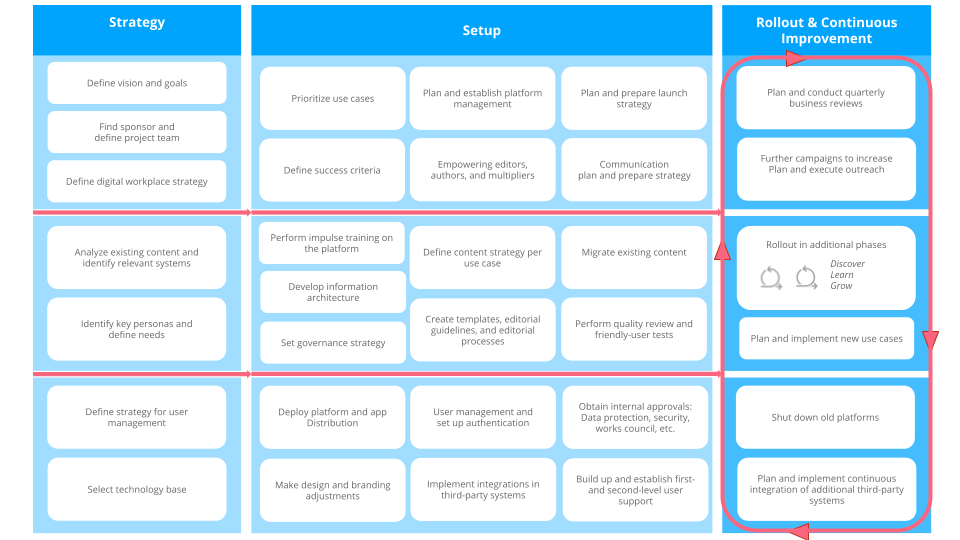
However, the project team must pay particular attention to ensuring that each task is addressed so that it can finally be checked off in the sense of a checklist. There are defined milestones between and within the phases. The milestones between the phases can also be referred to as quality goals (QG for short). In contrast to normal milestones, with quality goals the next phase can only be started after the project progress has met the minimum requirements.
In the following figure, we have formulated a checklist for the strategy phase. The setup phase can only be started after the minimum requirements for each work item have been met.
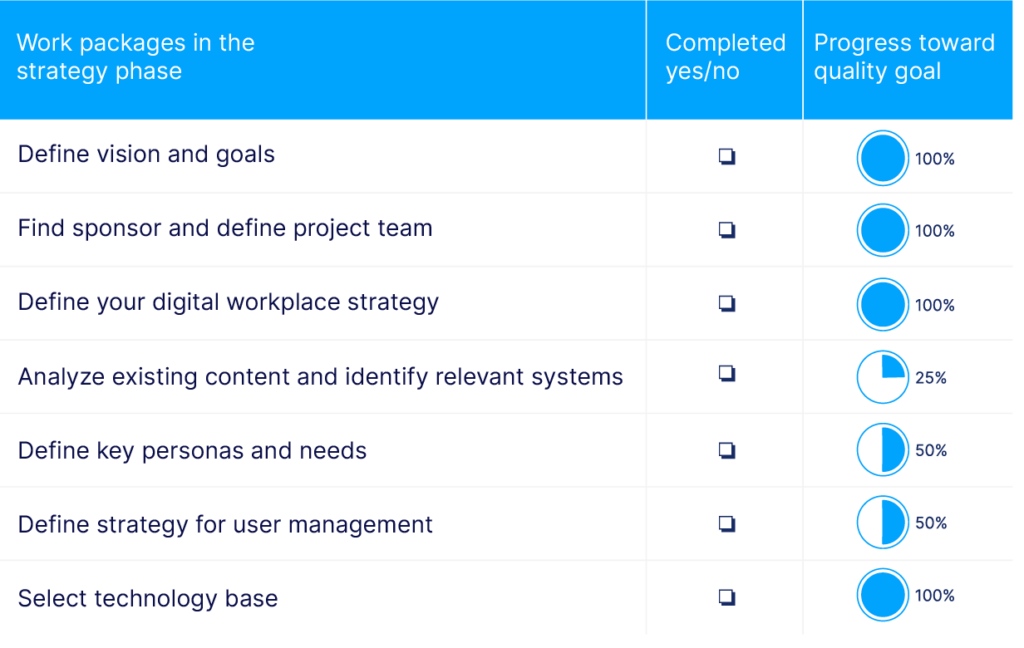
Tip 7: Despite all planning and preparation: Stay agile
The foundation for building a modern intranet was and continues to be laid in the strategy phase. However, recent years have shown that implementation based on a so-called "super tool" was a good idea in itself, but often failed in reality. By "super tool," I mean a software technology that attempted to cover every scenario from communication and collaboration to communities. As a result, the main focus of social intranets remained on office workers. You can read more about this in our article entitled "3 Problems with Social Intranet Platforms." It is important to form an opinion and to deal with the fundamental orientation of this exact issue.
SaaS solutions are the future of intranets
Internal communications then had to contend with a lot of issues, such as insufficient usability for editors, overly complex navigation structures, and a lack of intranet access from private devices for all employees. IT, on the other hand, had to invest a lot of resources in developments to meet the requirements of internal communication and other departments.
The IT trend is moving more and more towards SaaS solutions, so that even a tool evaluation is much easier to design than it was ten years ago. Standard solutions quickly give you an impression of what the future intranet may look like.
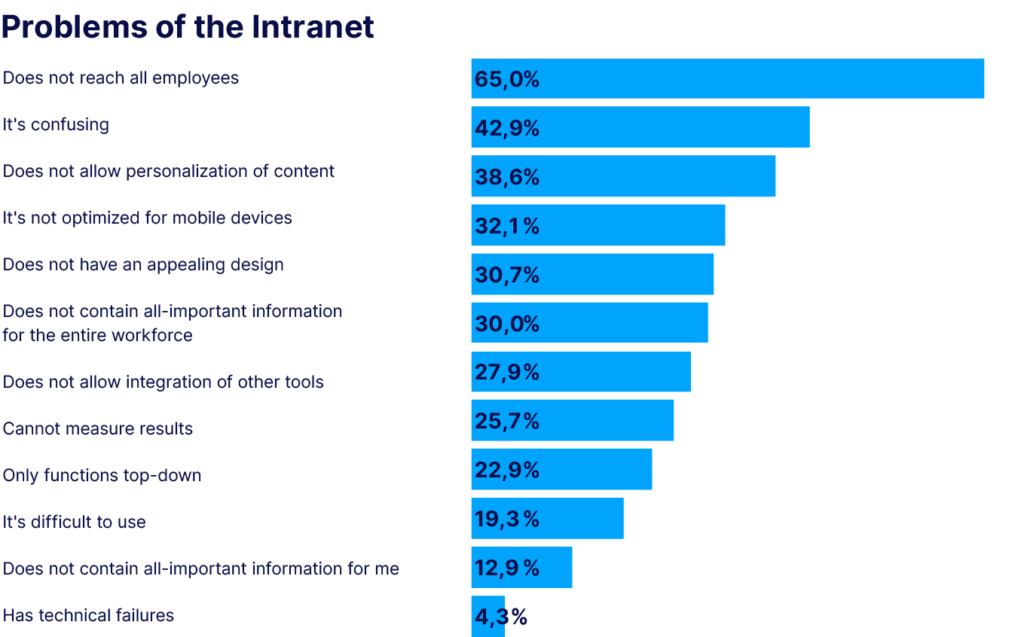
In contrast to 2010, the setup phase can also begin more quickly. This is mainly due to the fact that nowadays you no longer need rough and fine concepts for things like customizing and development. Internal communications can therefore focus more on intranet organization, target groups, and content, while IT resources can primarily be spent on user management.
Use cases can also be sketched out and tested more quickly. Depending on the initial situation, the focus of the setup phase can also be very different. For example, if an intranet already exists, there may be different strategies - complete replacement on Day X or a kind of parallel operation for a transitional period. In the second case, the focus of the new intranet is on news and then also becomes a gateway for content from the existing intranet. This scenario thus also enables a gradual transfer of content from the old to the new intranet.

Conclusion
The strategy phase is more important than ever - making the right decision at this stage lays the foundation for success. This is where you decide whether to "keep doing what you're doing" or redefine internal communications and the intranet. Established SaaS solutions with a clear focus on information and communication applications allow you to reach the setup phase more quickly, try out new concepts on an experimental basis, and continue to build on your success. In 2021, building a modern intranet will be fun again!




